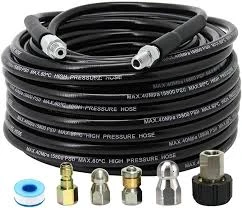Solutions for Resolving High Pressure in Power Steering Hoses for Optimal Performance
How to Fix High Pressure Power Steering Hose
Power steering plays a critical role in vehicle control, allowing for smooth and effortless steering, especially at lower speeds. One vital component of the power steering system is the high-pressure power steering hose. Over time, these hoses can develop leaks or become damaged, leading to reduced steering performance and potential vehicle safety issues. This article will guide you through the steps on how to fix a high-pressure power steering hose.
Understanding the High-Pressure Power Steering Hose
The high-pressure power steering hose carries hydraulic fluid from the power steering pump to the steering gear. Due to the immense pressure created by the pump, these hoses are designed to withstand considerable stress. However, factors such as extreme temperatures, wear and tear, or improper installation can lead to cracks or leaks.
Identifying the Problem
Before you begin any repair, it’s essential to confirm that the high-pressure hose is indeed the source of the problem. Signs of a failing power steering hose include
- Power steering fluid leaks underneath the vehicle. - A whining noise when turning the steering wheel, indicating low fluid levels. - Difficulty in steering, particularly at low speeds.
Check the hose for visible cracks, bulges, or fluid seepage. If the hose appears compromised, it's time for a replacement.
Tools and Materials Needed
To fix a high-pressure power steering hose, you’ll need the following tools and materials
- New high-pressure power steering hose (ensure it matches the specifications for your vehicle). - Basic hand tools (wrench set, socket set). - Pliers. - Fluid container for catching any spilled fluid. - Power steering fluid.
Steps to Replace the High-Pressure Power Steering Hose
Step 1 Prepare Your Vehicle
how to fix high pressure power steering hose

1. Park the Vehicle Place your car on a flat surface and engage the parking brake. 2. Gather Tools Assemble all necessary tools and materials so you have easy access to them during the repair.
Step 2 Drain the Power Steering Fluid
1. Locate the Reservoir Find the power steering fluid reservoir and remove the cap. 2. Drain the Fluid Use a container to catch any fluid that drains from the hose or reservoir during the replacement process.
Step 3 Remove the Old Hose
1. Identify Connection Points Trace the high-pressure hose from the pump to the steering gear and note the connection points. 2. Loosen and Remove Use the appropriate wrench to loosen the fittings at both ends of the hose. Once loose, carefully complete the removal by hand. Be cautious, as residual fluid may leak from the hose.
Step 4 Install the New Hose
1. Align the New Hose Position the new hose in the same route as the old one, ensuring there are no kinks or bends that could impede fluid flow. 2. Tighten Connections Attach the hose at both ends, tightening each fitting securely without over-tightening, as this can damage the hose or fitting.
Step 5 Refill with Power Steering Fluid
1. Add Fluid Pour new power steering fluid into the reservoir until it reaches the recommended level. 2. Check for Leaks Start the engine and turn the steering wheel from lock to lock. Inspect the hose and connection points for any leaks.
Step 6 Test Drive Your Vehicle
Take your car for a short test drive to ensure everything operates smoothly. If you notice any issues, recheck the hose connections and fluid levels.
Conclusion
Repairing a high-pressure power steering hose is a manageable task with the right tools and a bit of patience. Regular maintenance and prompt repairs can help keep your power steering system in top condition, ensuring safe and responsive vehicle handling. Always consult your vehicle’s manual for specific information and adhere to safety precautions during the repair process. If you're uncertain about any steps or encounter complications, don’t hesitate to reach out to a professional mechanic for assistance.
-
Ultimate Spiral Protection for Hoses & CablesNewsJun.26,2025
-
The Ultimate Quick-Connect Solutions for Every NeedNewsJun.26,2025
-
SAE J1401 Brake Hose: Reliable Choice for Safe BrakingNewsJun.26,2025
-
Reliable J2064 A/C Hoses for Real-World Cooling NeedsNewsJun.26,2025
-
Heavy-Duty Sewer Jetting Hoses Built to LastNewsJun.26,2025
-
Fix Power Steering Tube Leaks Fast – Durable & Affordable SolutionNewsJun.26,2025

